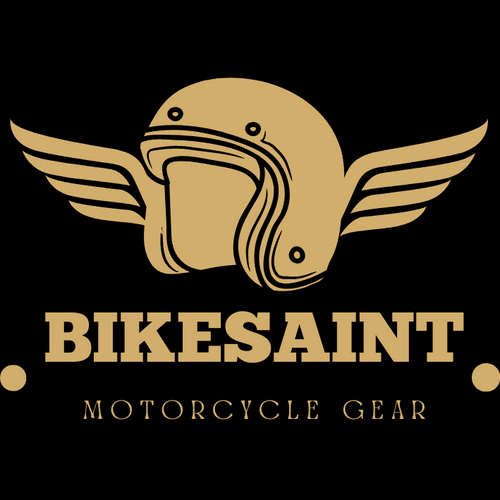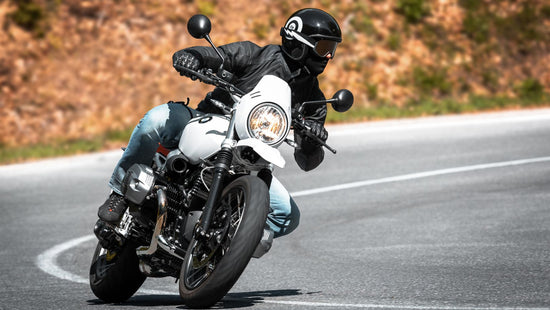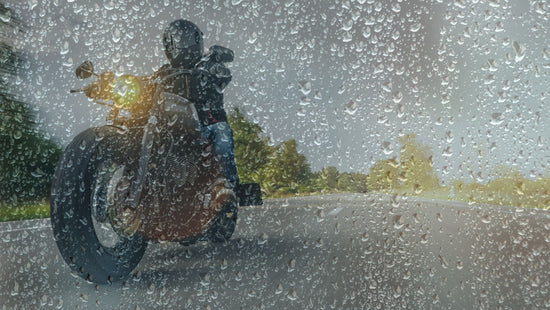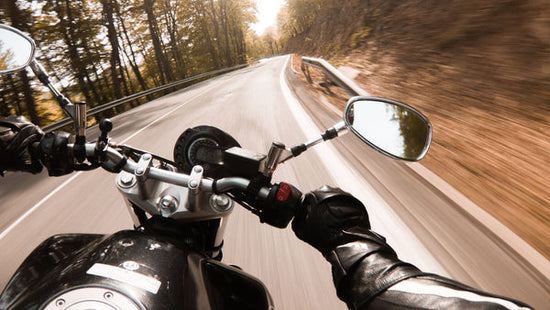

As a motorcycle rider, you know that your tyres are some of the most important components of your motorbike. They are responsible for keeping you safe, providing grip and stability on the road, and delivering optimal performance. In this blog post, we'll explore the world of motorcycle tyres and explain why they are essential for your safety and riding comfort. Whether you're a seasoned biker or a beginner, read on to learn more about motorcycle tyres.
Introduction
I would argue that the tyres are the one most important part of your motorcycle. They are your only contact with the pavement and their job is to keep it that way. No small job by any means, considering how small the contact patch is on every wheel - similar size to a match box. The demands on today’s motorcycle tyres are huge regarding traction, comfort and longevity.
Types of Motorcycle Tyres
Tubeless vs. tube tyres
It’s not really a matter of choice, but it depends on the wheels of your motorcycle, whether they are suited for tubeless or tube tires based on the rims. Tubeless tyres have been the choice of motorcycle riders and manufacturers for decades, as tubeless tires are more resistant to puncturing and you can easily repair them even on the go from the outside, without having to dismount your wheel and take out the tube. Tube tires you can probably find on old motorcycles or once the manufacturer makes a choice to give the motorbike some extra vintage feel and credit, as was the case with the BMW R nineT. Changing tube tyres for tubeless is not cheap, as it means that you have to change the wheels as well.
Sport vs. touring vs. sport touring
There are different types of motorcycle tyres to choose from, each designed to meet specific needs and riding styles. The three main types of motorcycle tyres are sport, touring, and sport touring. Sport tyres are designed for high-performance motorbikes, providing excellent grip and handling at high speeds and can be used for track days. Touring tyres, on the other hand, are designed for long-distance rides and offer superior comfort and stability with a focus on longevity. Sport touring tyres combine the best of both worlds, providing a balance of performance and comfort for riders who want the best of both worlds.
Differences in tyre construction
It is a hard job for tyre manufacturers nowadays. Consumers want the best grip, they want it on both dry and wet surfaces and they also want the tyres to last as long as possible. These demands are partially contradicting each other and it is about setting priorities or looking for the best balance.
Motorcycle tyres are either single compound or multicompound. Single compound means that they are made just from one material, being it soft with high silica content, which provides best possible grip, or hard, which provides the best longevity. Multi compound tyres are usually made of two different materials, making them hard in the middle to provide longevity on the long straight roads and soft on the edges for improved grip at high lean angles.
Another different types of construction are radial vs bias-ply motorcycle tyres.
Importance of Proper Tyre Maintenance
Regular checks for tire pressure and wear
Proper tyre maintenance is essential for your safety and the longevity of your tyres. Here are some tips to help you keep your tyres in top condition:
-Check your tyre pressure regularly and adjust as needed. Underinflated tyres can affect handling and increase the risk of a blowout. This is the easiest and most important way to maintain your motorcycle in a safe condition. It comes free only with a little bit of work. I check my tyres every week and before every longer trip. Most of the times it is not needed. My tyres are not losing air, but it is also a piece of mind knowing that my tyres are in a good shape and I can depend on them when I need it.
- Check the tread depth regularly to ensure that your tyres are not worn down. Most tyres have marks inside the tread to tell you how much of is left. The tread and its depth plays a role only in the rain and its job is to remove the water from under your wheels to prevent aquaplaning.
- Inspect your tyres for any signs of damage, such as cuts or punctures. If you notice any damage, replace the tyre immediately. Punctures can be easily repaired with tyre repair kits, but the tyres safety has been compromised. Manufacturers recommend replacing such tyres and I would say it depends on the speeds that you ride your motorbike. Speeds approaching or over 200 km/hr are not recommended for safety reasons on a tyre that has been punctured and repaired.
When to Change Motorcycle Tyres

How to determine when a tyre needs to be replaced
Change your tyres once your tread is low and its depth has reached the indicators. The tyre might be still safe to ride on in dry conditions, but its shape has probably suffered at this point as well. Usually your front tyre shape becomes pointy and your rear tyre flat. This negatively affect your motorcycle riding comfort and confidence, ast the motorcycle tends to drop suddenly into the lean instead of leaning gradually and smoothly.
It's important to note that even if your tyres have plenty of tread left, they can still be unsafe due to age and wear. Generally, motorcycle tyres should not be older than 5 to 6 years, regardless of how many miles have been ridden on them. And I mean 5 to 6 years since they have been manufactured, not since you have put them on your motorbike.
Here are some other signs that your tyres may need to be replaced:
- Cracks or cuts in the sidewalls
- Uneven wear patterns
- Excessive vibration or wobbling
- Bulges or blisters on the tyre
Factors affecting tyre lifespan
Except for the tyre itself, your riding style and how the tyre is used affects the tyre lifespan. If your motorcycle riding style is dynamic with heavy acceleration and braking, you will go through your tyres quicker and so will you, if you ride your motorbike with a pillion or on surfaces that are not smooth. Different motorbike riders get different lifespan out their tyres, but you can expect somewhere around 5000 km from sport tyres and double or triple on sport touring or touring.
Choosing the Right Motorcycle Tyre
Factors to consider when choosing tyres (performance, longetivity, handling)
Choosing a type of motorcycle tyre is about how you plan to use it and what you expect from it. It comes down to a choice between grip and longevity, with sport touring tyres offering a nice balance and being a popular choice among motorcycle riders who want to have some fun in the twisties, but also use their motorbike for commuting and longer distance trips.
Speeed rating and DOT (age) of the tyre
Choosing a type of motorcycle tyre is about how you plan to use it and what you expect from it. It comes down to a choice between grip and longevity, with sport touring tyres offering a nice balance and being a popular choice among motorcycle riders who want to have some fun in the twisties, but also use their motorbike for commuting and longer distance trips.
When choosing a set of tyres, obviously you need to pick the right size that you can find in your manufacturer’s manual as well as the motorbike’s technical ID. However when purchasing a tyre, look for the speed rating as well, W being the highest and recommended for speeds up to 270 km/h.
Another sign you should look for on the tyre itself is a DOT indicating when the tyre was manufactured. It is a 4 digit number on the side of the tyre, stating the week and year. For example DOT 0122 indicates production on the first week of the year 2022. Unfortunately, you cannot check this online, in case you want to make the order and have the tyres delivered.
Recommendations for different brands
My last advice is don’t go cheap with the tyres. It does not mean you cannot pick an older model in order to pay less. I myself use a Dunlop Sportmax Roadsmart 2, which is a model from 2012 that already has 2 successor models, but I find its price to quality ratio convenient. But go only for trusted renowned brands that have history in the motorcycle sport and industry. These include Michelin, Dunlop, Pirelli, Bridgestone or Metzeler, all of which offer a wide range of motorcycle tyre models.
New motorcycle tyres - watch out!
Brand new tyres are slippery. It is a result of the manufacturing process, when the tyre forms are treated with a non-stick emulsion in order for the tyres not to stick to the forms. Be aware of that as a motorcycle rider and adjust your motorbike riding and especially cornering to it. The emulsion will wear out pretty quick, as soon as you break in the surface of the tyre just a bit.
The key here is not to go for any big lean angles, but instead to increase your lean angles gradually, as you progress to wear the tyre off from the center to the sides. Watch out especially, if your first ride is on wet roads. What I do is to take some extra time to break in my new tyres. I am not taking them immediately for a trip or commute, but instead spend some time on empty roundabouts or parking lots.

Conclusion
In conclusion, choosing the right motorcycle tyre is crucial for your safety and riding comfort. It is important to consider factors such as performance, durability, and handling when making your decision. Sport touring tyres offer a nice balance between grip and longevity, making them a popular choice among motorcycle riders who enjoy twisties and use their motorbikes for commuting and longer trips.
When purchasing a tyre, it is important to look for the speed rating and the DOT indicating when the tyre was manufactured. Choosing trusted brands such as Michelin, Dunlop, Pirelli, Bridgestone, or Metzeler is also recommended even if the prices are higher.
Remember to maintain your tyres by regularly checking the pressure, tread wear, and alignment. Don't go cheap with tyres, as it could compromise your safety on the road.
As a motorcycle enthusiast, I understand the importance of having the right tyres for your motorcycle. By following these tips and recommendations, you can ensure a safe and enjoyable ride every time. Stay safe and keep the rubber side down!
What are the basic types of tyres for motorcycle?
There are different types of tyres available in the market, each designed for a specific purpose. Generally, there are three types of motorcycle tyres: 1. Sport tyres: These tyres are designed for high-performance sports motorcycles and are ideal for riders who want enhanced grip and handling at high speeds. They provide excellent cornering ability, but they wear out quickly. 2. Touring tyres: These tyres are designed for touring motorcycles and are ideal for riders who want a smooth and comfortable ride. They are durable and can handle long distances, making them perfect for long rides. 3. Off-road tyres: These tyres are designed for adventure and dirt bikes and are ideal for riders who want to ride on off-road terrains. They provide excellent traction on dirt and gravel, but they wear out quickly on asphalt.
What is the difference between radial and bias ply motorcycle tyres?
Radial tyres have become the most popular choice for most motorcycle riders. They are constructed with layers of cords running perpendicular to the direction of travel, with a belt of cords running around the circumference for added strength. This design allows the tyre to be more flexible and offer better grip and stability, especially on long rides and high speeds. Radial tyres also have a longer lifespan and offer better fuel efficiency. On the other hand, bias ply tyres use a design where cords are laid at a 30-45 degree angle to the direction of travel, with multiple layers stacked on top of each other. This design makes them stiffer and more resilient, suitable for heavy-duty work such as off-road or touring. They also have a thicker sidewall, providing better puncture resistance.
How often should I check my motorcycle tyres for air pressure?
deally, you should check your tyre pressure at least once every two weeks or before embarking on a long-distance ride. However, it's crucial to note that your tyre pressure can fluctuate depending on various factors such as temperature changes, load capacity, and riding style. Therefore, it's recommendable to check your motorcycle tyre pressure before every ride to ensure that it's at the recommended level. Maintaining the right tyre pressure is essential for several reasons. Firstly, it ensures optimal handling and stability, allowing you to manoeuvre safely on the road. Secondly, proper tyre pressure improves fuel efficiency, reducing the risk of frequent refuelling and saving you money in the long run. Additionally, maintaining the right tyre pressure improves the lifespan of your tyres, reducing the need for early replacement. To check your motorcycle tyre pressure, you need a tyre pressure gauge. Most motorcycle tyres' recommended pressure level ranges from 28 to 36 psi, depending on the tyre manufacturer and the motorbike's weight and size. The information on the recommended pressure level is usually indicated on the motorcycle's manual or the tyre manufacturer's website or the motorcycle itself.
How do I know when it is time to replace my motorcycle tyres?
1. Check the tread depth: The legal minimum tread depth for motorcycle tyres is 1mm. However, it is advisable to replace your tyres when the tread depth reaches 2mm. You can use a tread depth gauge to measure the depth and check for any uneven wear. 2. Look out for cracks and bulges: If you notice any cracks or bulges on your tyres, it is a clear sign that they need to be replaced. These can be caused by overinflation, underinflation, or simply wear and tear. 3. Check the age of your tyres: Even if your tyres look fine, they may need to be replaced if they are too old. Tyres typically have a lifespan of around five years, regardless of how much you ride. You can check the manufacturing date on the sidewall of the tyre to determine its age. 4. Pay attention to handling and performance: If you notice that your motorbike is not handling as well as it used to, or if you are experiencing more slips and skids than usual, it may be time to replace your tyres. Similarly, if you notice any vibrations or unusual noises coming from your tyres or sudden drops when leaning your motorbike.











